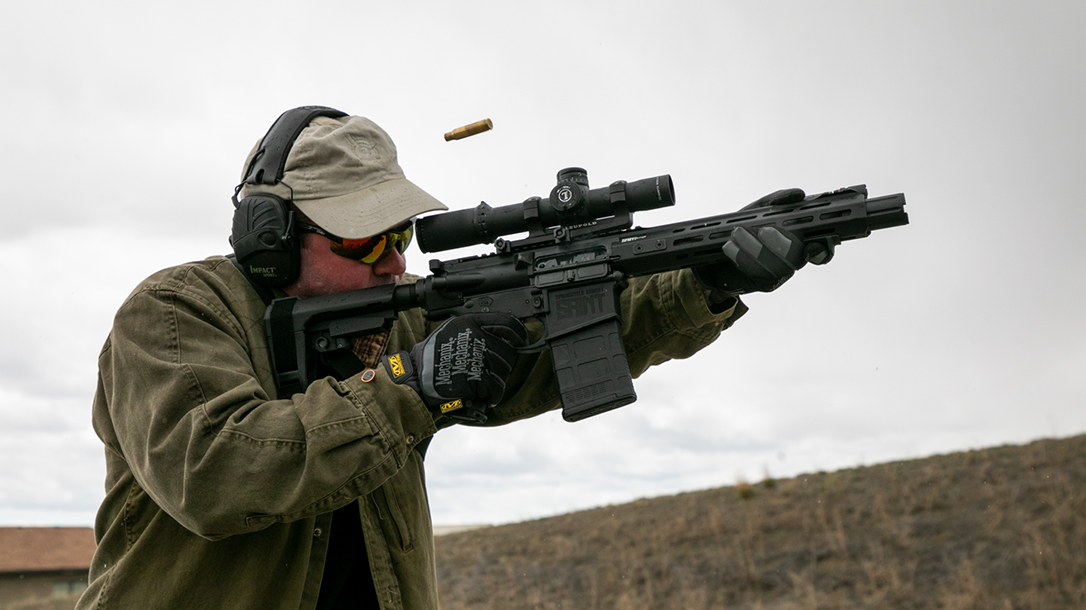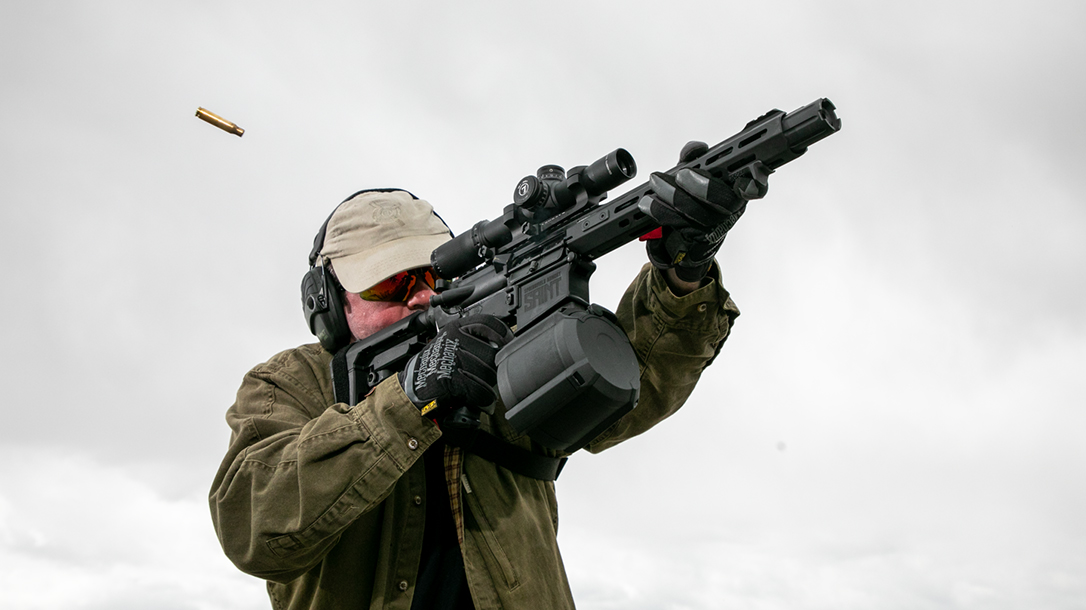The benefits of the AR-style firearm are well recognized. The benefits of a short barrel are also obvious to anyone who has had to wield a gun in a tight area, or pack it in a backpack, or deploy it from a vehicle. Finally, the .308 cartridge has approximately double the foot pounds of energy over the 5.56 in comparable shortened barrels. So Springfield Armory decided to throw something into the SAINT line of ARs that is a little unusual: a short-barreled, SAINT Victor pistol in .308.
Springfield Armory SAINT Victor Pistol 308 DETAILS
The Springfield Hellcat started a big stretch for Springfield Armory, and it continues with the new SAINT Victor Pistol. It has a 10.3-inch Chrome Moly Vanadium barrel and measures 28.25 inches overall with the arm brace fully collapsed, and 30.5 inches fully extended. It has a Bravo Company Gunfighter Mod 3 pistol grip and an SB Tactical SBA3, five-position arm brace that fits on a mil-spec buffer tube. The stock has a Quick Detach socket that is accessible from both sides. Plus there is a second QD socket at the rear of the lower receiver, built into the end plate, sitting below the castle nut. The fore-end is an eight-sided, 10.5-inch free-float, M-LOK-compatible handguard with two notches of Picatinny at both ends, on top of the handguard. It comes with a small forward hand stop attached to the bottom of the handguard.
The forged aluminum lower receiver utilizes a standard DPMS/KA-style with a built-in, oversized trigger guard. The Springfield logo adorns the left side with “Springfield Armory Saint” on the right. Springfield etched both into the aluminum, not just laser engraved, and they look sharp. The Accu-Tite Tension system comes built into the lower. This utilizes a polymer-tipped screw, accessed under the pistol grip. It adjusts until there is the perfect amount of pressure between the upper and lower receiver to get rid of the notorious AR “rattle.”

Springfield lists the trigger as a ho-hum mil spec trigger, but it is quite a bit more. First, it uses a straight, flat-face trigger that I love. Second, the trigger parts feature Nickel Boron coating. This has to be the best mil-spec trigger I have ever used. There is only a slight bit of creep and no grit. The reset is normal, but can be easily felt and heard. Normally I tell people to toss out their mil-spec trigger and upgrade to something better. Not in this case. This is a 10-inch workhorse, not a precision, target rifle. You will not notice any loss of accuracy due to the trigger.
Beefy Bolt & More
The bolt carrier group is beefy because it is a .308. Springfield makes its bolt from 9310 steel. Carpenter 158 is the mil-spec steel used for standard AR bolts, but 9310 is better. It is a little stronger, and these are magnetic particle inspected to make sure the steel is consistent. They are also high-pressure tested, and the bolt carrier group is Melonite coated for built-in lubricity. Melonite is harder and more corrosion resistant than chrome. Springfield also uses the Eugene Stoner-style of firing pin retaining pin instead of the usual cotter pin style. I don’t know if the Stoner-style pin is stronger, but it looks like it.
Hands down, my favorite feature of the SAINT Victor .308 pistol is the Springfield Armory, two-piece blast diverter. When I picked up the gun at my FFL, the owner asked me, “How badly do you think it will kick?” AR-10s typically have a lot more recoil than AR-15s. AR-15s have smaller receivers and are used for smaller calibers than AR-10s. Plus, short barrels make the blast and unpleasantness that much worse. Finally, in my opinion, arm braces are not as comfortable to shoot as normal stocks. I was expecting the worst, but found myself very surprised.

Muzzle blast wasn’t noticeable and recoil was only slightly more than a .223. The reason? It has to be the two-piece blast diverter. The internal part of the blast diverter does not look like a muzzle brake. It has a round build with a bunch of cross drilled holes. Nothing angled to send the blast back and reduce the recoil. It looks pretty benign. Then there is a fluted cylinder that screws on around that. Clearly it pushes all of the blast out the front, but you would think that would increase the recoil. Color me impressed.
Final Thoughts on the SAINT Victor Pistol in .308
There are two versions of the SAINT Victor Pistol in .308: The standard model comes with a 20-Round Magpul PMAG Gen M3, while the “low-capacity” variants comes with one 10-Round Magpul PMAG Gen M3. MSRP on both versions is $1,363. The pistol also comes with a clearly “made to fit” zippered bag. The bag features two Velcro straps to hold the gun in place and, lo and behold, still fits fine even with a red dot or scope attached.
Initially I thought I would only try this gun out with a red dot sight. After all, it is a pistol. But the added range of having it in .308 made me second guess that choice. I mentioned it to Shawn Skipper at Leupold and he agreed. He loaned me their Mark 8 CQBSS 1.1-8×24 tactical scope with illuminated Mil-Dot reticle and the Mark 6 34mm Integral Mount Scope made for AR-style firearms. Set the scope on 1.1 and it functions like a red dot. Turn it up to 8X if you want to reach out and touch someone. It truly was the perfect pair for the SAINT Victor pistol. I particularly liked how I could grab the knurled 3.5-inch rear with my whole hand and easily twist to change the magnification without fumbling.
The advantages of a short-barreled AR become readily apparent to anyone who picks one up. The advantages of the more powerful .308 over 5.56mm are also obvious. Putting the two together makes for a fantastic gun for your truck, ATV or home. The advantage of it coming with everything you need except the optic, with top of the line parts, and Springfield reliability make this an obvious choice for a lot of reasons. For more information go to springfield-armory.com.

![First Look: Springfield Officially Releases SAINT Victor AR-10 Pistol in .308 [VIDEO]](http://blade-city.com/cdn/shop/articles/springfield-victor-pistol-test-lead_{width}x.jpg?v=1591815050)






